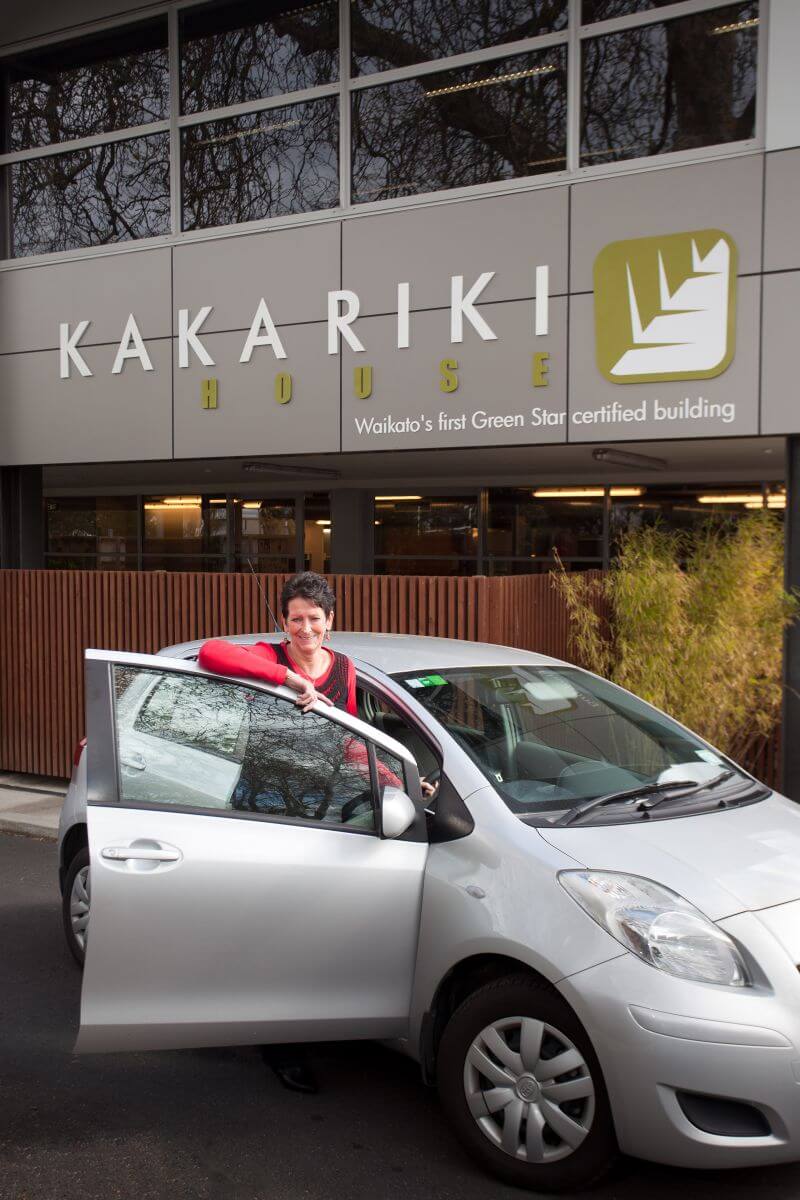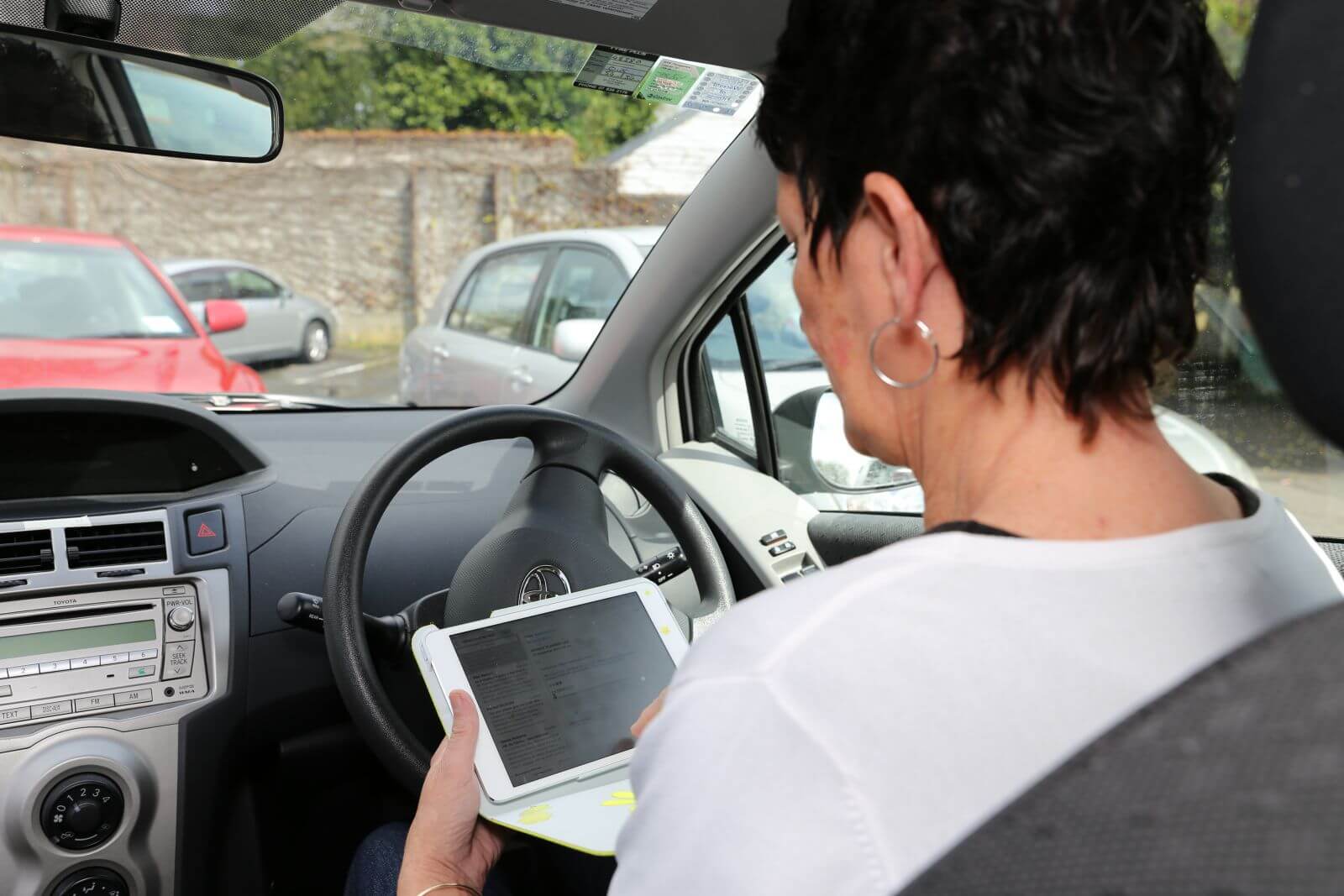A day in the life of a Pathways mobile support worker
Pathways supports people with experience of mental health issues to live well in the communities of their choice. It provides support in a wide range of areas such as practical daily living, housing, employment and being healthy.
Wise Group senior communication advisor Rachel McGuire spent a few days alongside Pathways support worker Sandy Skinner in Hamilton. Sandy was the 2013 recipient of the Pathways Trish Glen Achievement Award. Rachel shares some of the insights she gained into what a day in the life of a Pathways mobile support worker looks like.
There’s no such thing as a typical day. You just need to be fluid and see what each person needs that day – then you do whatever it takes.

It’s 10.30am on Monday morning and I arrive to go to the first appointment with Sandy. She is warm and welcoming and immediately starts telling me about her morning so far – responding to emails and messages, checking on notes and planning for her day ahead. “I like to put time into planning my day,” says Sandy. “If I make sure the day starts really positively and I’m as relaxed as possible when I go to see the people I support, then I can focus completely on them and give them my undivided attention.”
However, she is quick to point out that making a plan and things going to plan are not the same thing! “You never know what the day is going to bring. There’s no such thing as a typical day. You just need to be fluid and see what each person needs that day – then you do whatever it takes.” This won’t be the last time I hear Sandy describe what she does using the Pathways spirit ‘whatever it takes’. And another theme I will hear many times is “It’s not about me, it’s about them.”
We get in the car and head to see the first client, Pam*. “She’s done so well. You’ll see when we get there, her house is just so homely and she displays all her special things so beautifully,” says Sandy, who goes on to tell me that Pam had previously been in supported accommodation where she had things she had hoarded stacked up to her ceiling and couldn’t maintain a clean home. “I’m just so proud of how far she’s come,” Sandy adds.
We arrive at Pam’s home and Sandy greets her warmly and asks if she minds if I join them, which she doesn’t. Pam looks pleased to see Sandy and welcomes us in to her home which she clearly maintains with pride. Sandy chats cheerfully with Pam about how she is feeling and asks about her sleep and a few other things. She checks in with Pam about how she is getting on with connecting with a friend to visit the pools via the bus. Sandy suggests to Pam that she mark her calendar for that day to help her remember. Pam mentions she has a plan to pay some extra towards her pharmacy bill and Sandy goes through the bill with Pam to check the automatic payment she had helped her set up was coming off.
We say goodbye to Pam after Sandy has spent a bit more time with her, artfully weaving in lots of opportunities for Pam to open up if there is anything concerning her, and always reading between the lines of what Pam says. Sandy leaves, content that Pam seems to be doing really well.
As we drive to the next appointment to see John*, Sandy slows down along the main shopping strip. “I’m just keeping an eye out for John as he’s sometimes sitting on that bench over there or he might even be at the bank.” There’s no sign of him so we carry on to his house. On the way Sandy shares her frustration with the situation surrounding John. “He’s got the biggest heart and people just take advantage of him. He’s had someone staying with him who left him with big bills and never paid a cent. I’ve been trying to help him to get the confidence to say no and focus more on looking after himself.”
I stay in the car as Sandy goes in to check with John if it’s ok for me to come in. John is clearly agitated and looking for something so Sandy immediately starts helping him to find his lost front door key. After having no luck finding the key, Sandy makes a note to contact the landlord so John can get another key cut, and we sit down to talk about how John is doing. He sits hunched forward but Sandy soon brings him out of his shell and he starts to sit up straight and show glimpses of his cheeky sense of humour.
John is worried about his large overdue power bill. Sandy emphasises it’s important that he does something about it so his power doesn’t get cut off. Together they call the power company, with Sandy always asking John what he wants to do and giving him every opportunity to talk directly to the power company as much as he is comfortable with. It soon becomes apparent the situation is worse than they initially thought. This month’s power has been added to the bill, bringing the total owing to more than $500. John’s unplanned lodger has clocked up a bill you might expect for a five bedroom house, not the small one bedroom unit he lives in. This cost is on top of the $600 bill for broken windows the person has left John with.
After at least half an hour on the phone to the power company and then Work and Income, they figure out John will need to go to Work and Income to make a plan for dealing with these expenses, which are well beyond his ability to pay on the benefit he receives. They decide they will stop in at Work and Income when Sandy takes John to the shops for some food after their catch up.
We head to the shops – John goes to the butcher and vege shop for some meat, bread and milk, while we look in another shop to find out how much cooking pots are (Sandy found out in her earlier conversation that John doesn’t have any pots to cook with.) On seeing the price, Sandy makes a note to check with her team in case anyone has access to some pots John could have. We meet back up with John and head to Work and Income where Sandy is able to secure an appointment with them for first thing the next morning.

I feel an even stronger sense of the importance of the work I do in supporting people like Sandy with being able to communicate and connect with the people they support.
I leave Sandy for the day at the Pathways office where she starts to follow up on all the action points she has been noting throughout the day and add her notes to Recordbase. This is something that she would normally have been trying to do on her iPad in the car between appointments, but didn’t because she was taking every spare moment to talk with me and help give me insight into what it means to be a support worker. Talking about her iPad, Sandy is enthusiastic. “I can’t imagine being without it now, it’s such a great way to work and involve people in their care. I’m really looking forward to when we can do even more activities on the iPad,” she says.
My time with Sandy has been a real eye opener for me. I am humbled by Sandy’s absolute passion and genuine caring and optimism for the people she supports – knowing there are hundreds of other support workers in Pathways also doing ‘whatever it takes’’ on a daily basis. I feel privileged to have met and got to know some wonderful people and I feel an even stronger sense of the importance of the work I do in supporting people like Sandy with being able to communicate and connect with the people they support.
*Not their actual names
